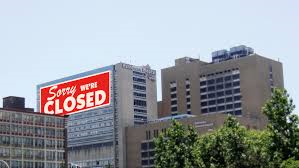
While Mr. Schultz and I have not always seen eye to eye on healthcare issues, we are in lock-step on the importance of training more primary care physicians to improve access to the services they provide. This clinic will house the Northwest Family Medicine Residency Program, currently composed of 16 family medicine resident doctors—which will ultimately grow to 24—and 10 faculty instructors.
In my opinion, supporting the NFMR program should be a top priority in order to ensure enough primary care physicians are available on the Olympic Peninsula over the next 50 years. When corporations and communities do not lend support to their physicians-in-training, that failure can be catastrophic.
This past summer, Hahnemann University Hospital—a teaching site for Drexel University College of Medicine in Philadelphia—closed their doors. When Hahnemann closed, its’ residents were essentially “orphaned,” losing their jobs overnight. Residency refers to the post-graduate training period following medical school graduation compulsory for a physician to be licensed to practice medicine. After “matching” to an open residency position at a given teaching hospital, resident training begins across the entire nation on July 1st every year once a contract is signed with the employing organization.
When I applied to residency 20 years ago, there were more spots available than applicants to fill the positions, however in 1997, the federal funding allocated to residency positions was capped. Despite the fact there have been more physicians churned out by more medical schools in an attempt to meet the increasing demand for physicians, the number of residency positions has not changed, which has created an alarming bottleneck.
Today, as a consequence of capped funding, only 79 percent of the 38,000 applicants successfully matched to a first-year residency position in 2019, leaving nearly one in five medical school graduates jobless. Hahnemann added 570 residents and fellows to an already-growing unemployment list.
The Hahnemann orphans have nowhere to go. And even if they could secure training positions elsewhere, Hahnemann inexplicably refused to release the contracts, leaving countless physicians—55 of whom hold J-1 visas and face deportation if unable to secure new jobs within 30 days of the hospital closure—on uncertain ground.
Hahnemann was once a venerable safety-net for poor and disenfranchised patients in the inner-city for more than 170 years, yet having a proportionally larger Medicare and Medicaid patient population made them vulnerable to closure. And they are not alone. More than a dozen U.S. hospitals have filed for bankruptcy since January 1st of this year, according to Becker’s Hospital Review, most likely due to declining Medicaid and Medicare reimbursements.
As a part of bankruptcy proceedings, Hahnemann decided to sell off 570 residency “positions” at auction instead of releasing the contracts, making residents akin to financial assets. The Centers for Medicare and Medicaid Services (CMS) deemed the sale illegal, yet the positions garnered an astounding $55 million at auction, making each physician worth approximately $100,000. And on September 5, despite CMS objections, U.S. Bankruptcy Judge Kevin Gross approved the sale of Hahnemann University Hospital’s medical residency programs to Thomas Jefferson University Hospitals Inc. for $55 million, acknowledging his ruling could “cause a judge to lie awake at night.”
This ruling should keep us all awake at night as this decision sets a dangerous legal precedent. One we must hope is not repeated anytime soon. Hospitals and medical clinics are struggling to stay afloat on the amount that the Centers for Medicare and Medicaid (CMS) pay for healthcare services. And while the “Orphans at Hahnemann”—570 physician residents and fellows—are the first to be auctioned off, they will certainly not be the last.
Kitsap County is extremely blessed to have the Northwest Family Medicine Residency Program and our community already benefits greatly from their presence. There are 8 new resident physicians who began training on July 1st.
If you have not yet met them or had the pleasure of working with them, I encourage you to stop by their current clinic over on Wheaton Way with a basket of goodies or a warm home-cooked meal to welcome them to Kitsap County. And if you get the chance, share some words of encouragement for the work they are already doing to make Kitsap County a better place. Remember, we want every one of these family physicians to call this community home very soon.